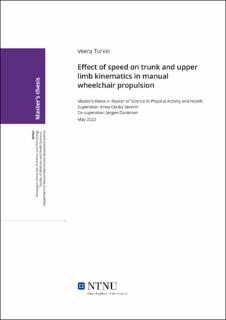| dc.description.abstract | Speed has been shown to affect movement patterns in manual wheelchair propulsion, and previously, mainly predetermined or self-selected submaximal speeds have been studied in non-athletes. This study investigated the effects of speed on trunk and upper limb kinematics in propulsion. Eighteen novice, able-bodied individuals (10M, 8F; 33±1yrs) propelled a wheelchair on a treadmill with 2.5% incline during an incremental test. Three-dimensional movements were recorded for 30 seconds at 1.11m/s and at near maximal speed with an 8-camera Qualisys system (120Hz). Start and end of push phase (contact and release) were identified, and maximum and minimum joint angles, range of motion and peak movement velocities between the two speeds were compared by paired t-tests (α=0.05). Cohen’s d was used to indicate effect size. Right side was analysed, since limb movement asymmetries in the sagittal and frontal planes were small (<6°). From submaximal to maximal speed, cycle length (p<0.018, d=0.62) and rate (p<0.001, d=1.75) increased, as push time (p<0.001, d=-3.00) decreased. Largest changes in movement patterns were seen as increased maximum (p<0.001, d=1.82) and minimum (p<0.001, d=1.79) trunk flexion. At contact, the shoulder was less extended (p<0.001, d=1.22), more abducted (p<0.001, d=-1.11), and less externally rotated (p=0.001, d=0.99), while the elbow was more flexed (p<0.001, d=1.84) and forearm less pronated (p<0.001, d=1.74). At release, the shoulder was more abducted (p<0.001, d=-1.28) and elbow more flexed (p=0.001, d=0.86). Movement velocities increased in all movement planes during push (p<0.05), with the largest increases detected in shoulder internal rotation and trunk flexion. At near maximal speed, there is less time to extend the trunk and shoulders before a new push, challenging propulsion movements. It is likely that factors limiting movement production at high speed relate to technique and movement control, in addition to fatigue. | |
